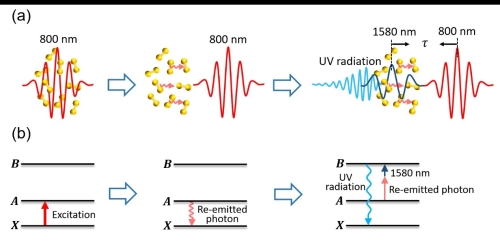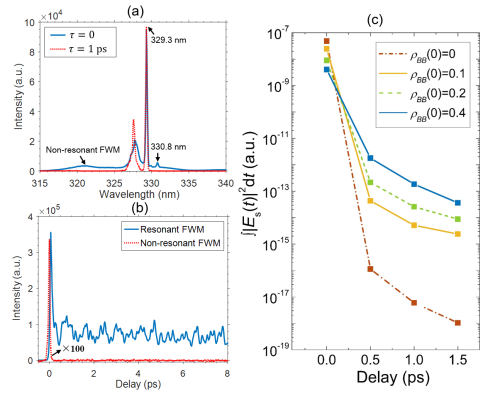Exploring quantum optical phenomena in the remote atmosphere attracts broad interests for fundamental physics and potential applications. Recently, a collaborative team from Shanghai Institute of Optics and Fine Mechanics, Shanghai Jiao Tong University, etc., has demonstrated the photon retention in the coherently excited nitrogen ions. Coherent photons, facilitated by quantum coherence, have been measured in strong-field ionized molecules, which unveils the potential for further exploration of fundamental light-matter interactions and optical information storage in the remote atmosphere. The results were published in Science Bulletin on Aug. 15, 2021.
Quantum coherence is of fundamental importance in the field of quantum optics, which plays an essential role for manipulating photons through the light-matter interaction. Many existing quantum optical platforms in studying quantum coherence depend on laboratory artificial gases, such as alkali metal vapor, Rydberg gas, and cold atoms. It is thus of great significance to search alternative solutions involving more abundant elements and molecules which are also less chemically reactant and safe to use.
Nitrogen molecule, which is the most abundant gas in the atmosphere, turns out to be a potential candidate for exploring quantum coherence effects. Atmospheric nitrogen can be ionized by using high-intensity femtosecond pulses, with the produced molecular nitrogen ions exhibiting rich energy levels for light-matter interactions. Hence, quantum coherence effects in strong-field-ionized molecular ions can be greatly explored towards coherent quantum control of photons.
In this study, the researchers have demonstrated the photon retention in the coherently excited nitrogen ions. After the nitrogen gas is ionized by a strong femtosecond laser, photons are retained through the quantum coherence. A time-delayed second femtosecond pulse is used to trigger two-photon resonant absorption with the retained photon in the ionized nitrogen molecule, resulting in a strong ultraviolet radiation. Such photon retention in atmospheric gas with strong ionization points to potential applications of optical information processing as well as coherent optical information storage at room temperature in the remote atmosphere.
This work was supported by National Natural Science Foundation of China, National Key R&D Program of China, Shanghai Municipal Science and Technology Major Project, Program of Shanghai Academic Research Leader, Natural Science Foundation of Shanghai, Strategic Priority Research Program of Chinese Academy of Sciences, Youth Innovation Promotion Association of Chinese Academy of Sciences, etc.

Fig. 1 Schematic illustration of the photon retention with nitrogen ions. (Image by SIOM)

Fig. 2 Ultraviolet radiations produced by re-emitted photons in coherently excited nitrogen ions. (a) Measured spectra and (b) dynamics of ultraviolet radiations. (c) Simulated signal intensity versus delay for different excited-state populations. (Image by SIOM)
Article website:
https://doi.org/10.1016/j.scib.2021.04.001
Contact:
WU Xiufeng
General Administrative Office
Shanghai Institute of Optics and Fine Mechanics, CAS
Email: xfwu@siom.ac.cn
Web: http://english.siom.cas.cn/